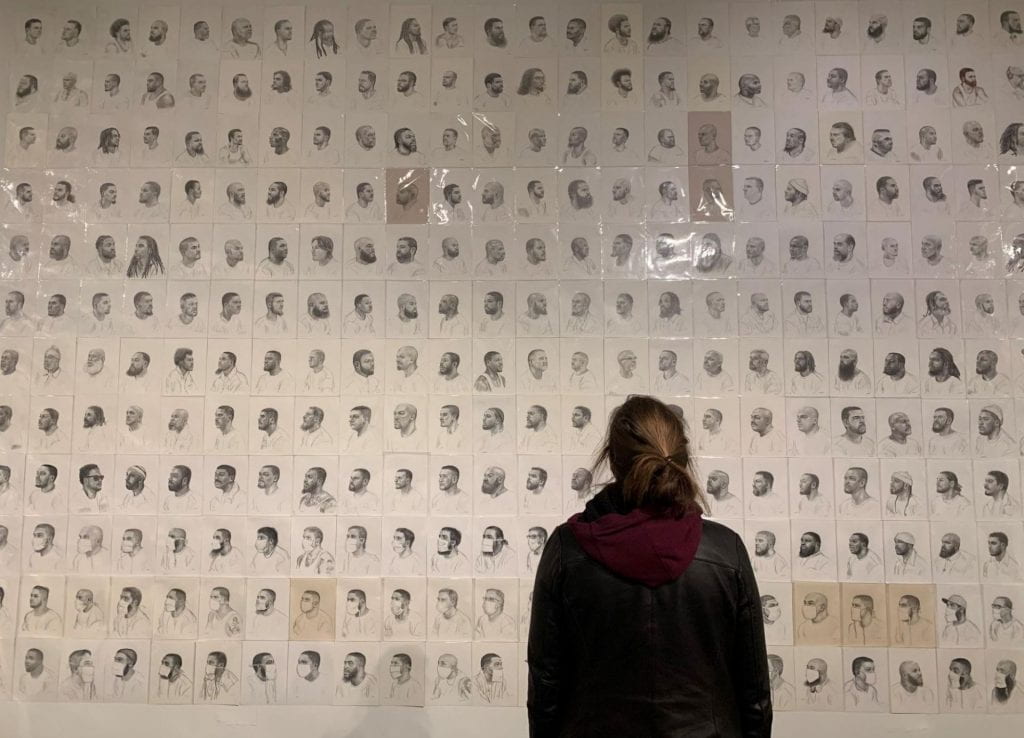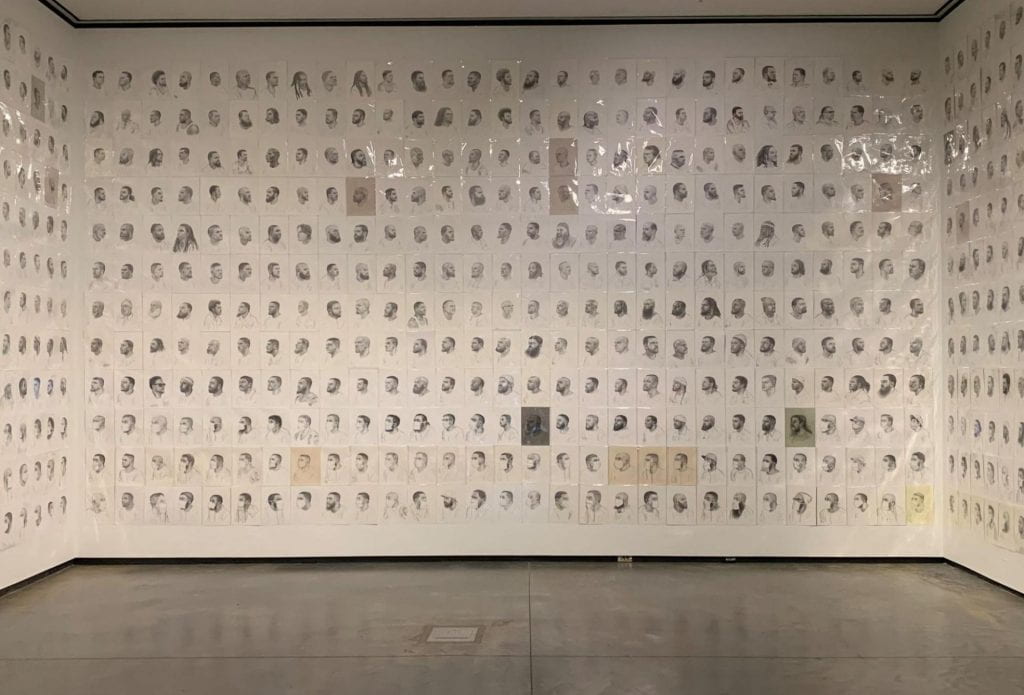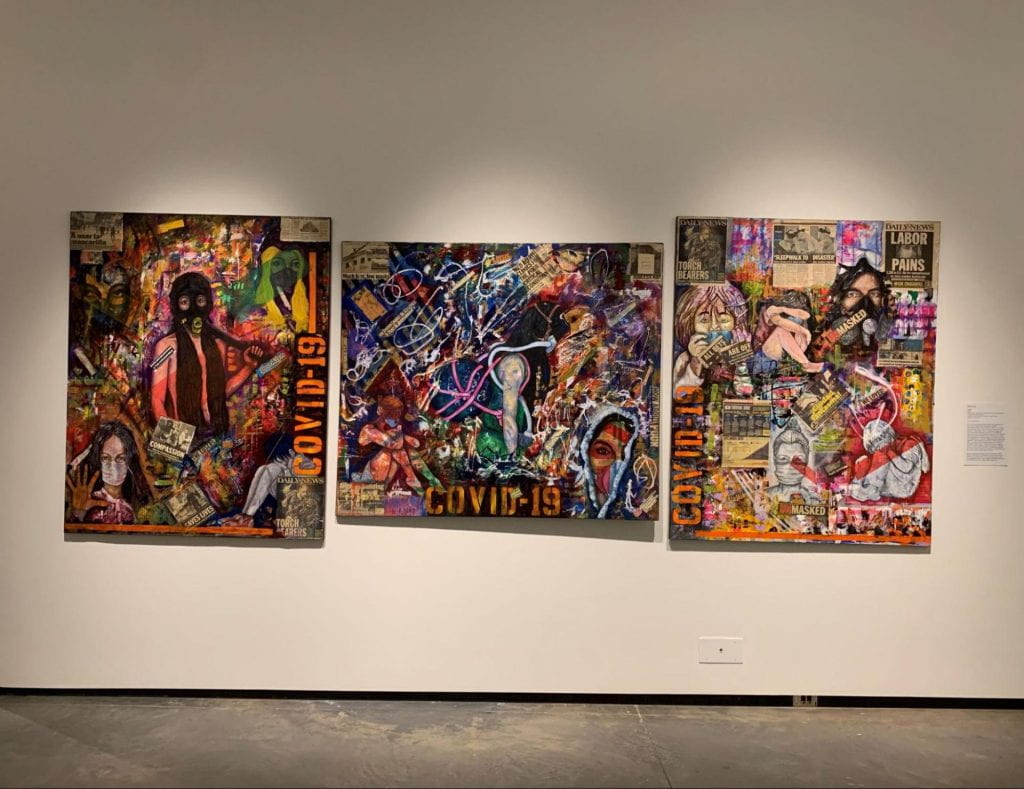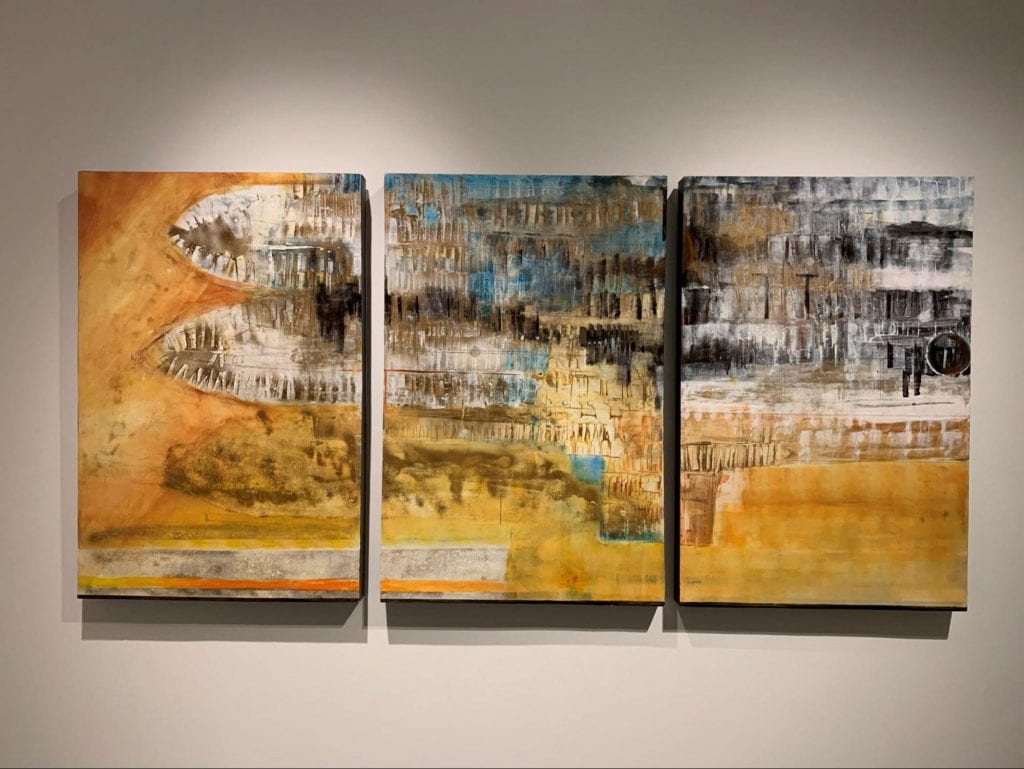The Exhibit

The Abroms-Engel Institute for the Visual Arts (AEIVA) has welcomed a new exhibit, “Marking Time: Art in the Age of Mass Incarceration”. The exhibit explores the United States’ criminal justice system, mass incarceration, discrimination and the very concept of justice with works from more than 70 different artists. Many of the pieces on display come from artists who are or were incarcerated, who used art as an essential outlet and form of expression within prison. Nonincarcerated artists are also featured, influenced by the damages of mass incarceration within their families and neighborhoods. The entire exhibit creates a critique of mass incarceration from a human right’s perspective, representing the voices of incarcerated persons that are typically silenced or ignored. “Marking Time” boasts three galleries of moving pieces that speak to the gravity and scale at which the human rights violations within our punitive justice system disenfranchise impoverished and minority communities throughout the United States, and features data and interviews that discuss ways these glaring problems should be addressed and combatted.
“Marking Time” was organized by curator Dr. Nicole R. Fleetwood, who has spent a decade researching the importance and development of visual arts and creative practices for incarcerated persons. Dr. Fleetwood deliberately removed any mention of charges or reasons for conviction for the incarcerated artists featured in the exhibit, forcing viewers to remove a layer of prejudice or thought regarding whether or not the artist is inherently a “good” or “bad” person, or deserving of their incarceration. As I progressed through the galleries of “Marking Time ”, one of the first things I noticed was exactly that; how I continuously perceived the artworks as being the creations of a fellow artist, not a criminal or prisoner. This intentional shift in perception creates an environment of thoughtfulness, analysis and depth that may not have been achieved otherwise, and makes the exhibit an excellent ignition for thought, conversation and activism.
When analyzing the works themselves, I was surprised to see how many were masterfully created from hair gel, sheets, uniforms, newspapers and contraband items when traditional art supplies were not accessible. Incarcerated artists are often limited in the tools they have to create art from, but countless works within “Marking Time” reveal the true resilience of an artist’s spirit, and how artistic expression can prevail above the smothering limitations of prison.
The Pieces
As this exhibit has been analyzed and discussed through its many travels from MoMA to AEIVA, I wanted to highlight a few of the pieces and discuss their particular significance to the conversation of human rights within the United States punitive justice system and mass incarceration.
Pyrrhic Defeat: A Visual Study of Mass Incarceration by Mark Loughney

Loughney’s series, Pyrrhic Defeat, is named for a theory within criminal justice studies that explores how a failing criminal justice system that discriminates in its criminalization of certain groups substantially benefits certain elites. Mark Loughney has created over 750 portraits of his incarcerated peers in order to mark the passage of time within his own sentence, as well as provide fellow inmates with a positive alternative to the dehumanization caused by mugshots and prison IDs. His pieces provide the individuals with a level of personalization, dignity, and respect that is often forgotten and ignored within the prison system. Loughney spends 20 minutes on each sketch, and has to carve a creative, open atmosphere for each session out of the typical chaos and disruptions within a prison environment.
Untitled by Gilberto Rivera

This Triptych by Gilberto Rivera places a spotlight on how mismanagement of the Covid-19 pandemic negatively impacted vulnerable communities throughout the artists’ hometown of New York. Rivera was a graffiti artist prior to his incarceration, and this piece truly reveals the artist’s emotions and style in a brilliant display of keywords, colors and figures. Rivera’s triptych incorporates newspaper clippings that highlight his disgust for how minority and immigrant essential workers were neglected as well as the fear incarcerated people experienced throughout the public health crisis. Prisoners across the globe were put into lockdowns to prevent the spread of Covid-19, and the result of this is an experience extremely similar to that of solitary confinement; a punitive mechanism proven to have extreme mental and physical health consequences. Despite these sweeping lockdowns, extreme overcrowding lead prisons to host the majority of the largest single-site outbreaks since the start of the pandemic. Despite these major outbreaks and casualties, prisoners fell to the bottom of priority lists for treatment and aid when medical equipment and essential items faced shortages. Rivera’s piece displays frustration and criticism of these issues that have hardly received the mainstream coverage they deserve.
Ellapsium: master & Helm by Jared Owens

With Ellapsium, Jared Owens addresses the racism of the criminal justice system as well as hierarchies and power struggles within Fairton, the correctional institution where Owens was imprisoned. This complex work features symbolism as a form of rebellion and disapproval, and bears an immediately recognizable resemblance to the infamous map of the Brookes Slave Ship from 1788 that displays how slaves were forced to live through their passage to America. This intentionally chosen symbol represents the violence, dehumanization, and other atrocities that slaves faced in early American history. The second and less known image present in this work is a blueprint of the Fairton prison; Owens’ combining of the two blatantly compares the horrors of the historical institution of slavery to the atrocities and discrimination committed by the United States’ current carceral state. Owens also utilizes color symbolically throughout his piece, and all of the colors used correlate to the artist’s daily life within a federal institution. The green of the institutional walls represents restriction and being subdued, blue represents the uniforms worn by prison guards, and brown represents the uniforms of those imprisoned. Orange, the most used color within the piece, was used within Fairfield to indicate areas that were off limits and unavailable to incarcerated persons, so Owens deliberately used that color for the boundary between the blueprint of the slave ship, of Fairfield, and the world outside of the two.
Owens is open about how his pursuit of art posed a legitimate threat to him within the Fairfield facility. Being caught with planks of wood to paint on or stretch canvas could have resulted in solitary confinement, extension of his sentence, or complete confiscation of personal possessions and art supplies. While these overwhelming restrictions greatly limited Owens while he was in prison, he has chosen to use his experience to create, raise awareness, and call for change- like so many artists featured alongside him in “Marking Time”.
Peace, Love, Harmony by Susan Lee-Chun

Women on the Rise! (WOTR) was a feminist art project founded by Dr. Jillian Hernandez to provide girls in juvenile detention facilities with a platform for self-expression and dialogue. Inspired by her participation in this project, Susan Lee-Chun worked with a group of girls in juvenile detention to explore the politics of fashion, and asked her participants to “Think about who you are, what words, images or symbols define you or your beliefs. Use them to create a fabric design”. The resulting hoodies on display conform to detention center uniforms on their exterior, and on the inside feature patterns with rainbows, checkers, and the word “Love”. Upon completion of this project, Lee-Chun attempted to give the girls she worked with the resulting hoodies of their creation; and was denied that request. None of the girls involved were allowed to wear the hoodies. In public defiance, Lee-Chun’s hoodies now hang among the many artworks of “Marking Time”, criticizing a system that would prioritize conformity and uniform over the individuality, creativity and expression of a child.
How To See “Marking Time”
If you would like to see “Marking Time” and any of the artworks or artists featured above first hand, the exhibit is free and available to the public until December 11. Reserve your free ticket to view the exhibition here. Spaces per time slot are limited to 10 for a one-hour long visit. If you cannot make your time slot for any reason, please cancel the booking or call 205-975-6436. If you have any issues with booking your ticket or would like to reserve a group tour, contact AEIVA at aeiva@uab.edu.
Visitors must wear a mask at all times inside the AEIVA building and keep socially distanced. Free and metered parking is available along the streets surrounding AEIVA. Safety is UAB’s priority. The pandemic is a fluid situation that UAB is monitoring, in consultation with infectious disease and public health experts; events will be subject to change based on the latest COVID-19 safety guidelines.
All upcoming “Marking Time” programs are designed as hybrid events, with both in-person and virtual components. AEIVA is prepared to move any of the events entirely virtual at a moment’s notice. Visit AEIVA on Twitter, Instagram and Facebook for the latest updated information.

